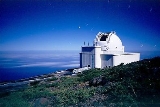
Isaac Newton Telescope
Encyclopedia
The Isaac Newton
Telescope or INT is a 2.54 m (100 in.) optical telescope
run by the ING
at Roque de los Muchachos Observatory
on La Palma
in the Canary Islands
since 1984.
Originally it was situated at Herstmonceux Castle
in Sussex
, England
, which was the site of the Royal Greenwich Observatory after it moved away from Greenwich due to light pollution. It was inaugurated in 1967 by Queen Elizabeth II
. The telescope is now one member of the Isaac Newton Group of Telescopes
.
However, Herstmonceux suffered from poor weather, and the advent of mass air travel made it plausible for UK astronomers to run an overseas observatory. In 1979, the INT was shipped to La Palma, where it has remained ever since. It saw its second first light in 1984, with a video camera.
Today, it is used mostly with the Wide Field Camera (WFC), a four CCD
instrument with a field of view of 0.5 square degrees which was commissioned in 1997. The other main instrument available at the INT is the Intermediate Dispersion Spectrograph (IDS), recently re-introduced having been unavailable for a period of several years.
telescope, with a 2.54 m (100 in) diameter primary mirror
and a focal length
of 8.36 m (329 in). The mirror weighs 4361kg (9614 lb), and is supported by a polar disc/fork type equatorial mounting. The total weight of the telescope is around 90 tons. The f/3.29 Prime focus, used with the WFC, allows an unvignetted field of view of 40 arcminutes (approximately 0.3 square degrees). There is also a secondary focal station, the f/15 Cassegrain focus, which possesses a 20 arcminute field of view and is the mount point for the IDS. The telescopes second first light was done by video.
The pointing accuracy of the telescope is around 5 arcseconds, but a sophisticated autoguider, which tracks a given guide star
and makes small corrections to the telescope tracking, allows a guiding accuracy of better than an arcsecond on better than 20th magnitude guide stars in support of the typical 0.8-1.5 arcsec seeing
at the INT.
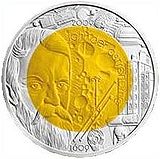
(1967-79) then ORM (1984-).
Largest optical telescopes 1967:
Large visible-light optical ground telescopes in 1984:
Isaac Newton
Sir Isaac Newton PRS was an English physicist, mathematician, astronomer, natural philosopher, alchemist, and theologian, who has been "considered by many to be the greatest and most influential scientist who ever lived."...
Telescope or INT is a 2.54 m (100 in.) optical telescope
Telescope
A telescope is an instrument that aids in the observation of remote objects by collecting electromagnetic radiation . The first known practical telescopes were invented in the Netherlands at the beginning of the 1600s , using glass lenses...
run by the ING
Isaac Newton Group of Telescopes
The Isaac Newton Group of Telescopes or ING operates the William Herschel Telescope, Isaac Newton Telescope and Jacobus Kapteyn Telescope optical telescopes for the Science and Technology Facilities Council , the NWO and the IAC...
at Roque de los Muchachos Observatory
Roque de los Muchachos Observatory
Roque de los Muchachos Observatory is an astronomical observatory located in the municipality of Garafía on the island of La Palma in the Canary Islands...
on La Palma
La Palma
La Palma is the most north-westerly of the Canary Islands. La Palma has an area of 706 km2 making it the fifth largest of the seven main Canary Islands...
in the Canary Islands
Canary Islands
The Canary Islands , also known as the Canaries , is a Spanish archipelago located just off the northwest coast of mainland Africa, 100 km west of the border between Morocco and the Western Sahara. The Canaries are a Spanish autonomous community and an outermost region of the European Union...
since 1984.
Originally it was situated at Herstmonceux Castle
Herstmonceux Castle
Herstmonceux Castle is a brick-built Tudor castle near Herstmonceux, East Sussex, United Kingdom. From 1957 to 1988 its grounds were the home of the Royal Greenwich Observatory...
in Sussex
Sussex
Sussex , from the Old English Sūþsēaxe , is an historic county in South East England corresponding roughly in area to the ancient Kingdom of Sussex. It is bounded on the north by Surrey, east by Kent, south by the English Channel, and west by Hampshire, and is divided for local government into West...
, England
England
England is a country that is part of the United Kingdom. It shares land borders with Scotland to the north and Wales to the west; the Irish Sea is to the north west, the Celtic Sea to the south west, with the North Sea to the east and the English Channel to the south separating it from continental...
, which was the site of the Royal Greenwich Observatory after it moved away from Greenwich due to light pollution. It was inaugurated in 1967 by Queen Elizabeth II
Elizabeth II of the United Kingdom
Elizabeth II is the constitutional monarch of 16 sovereign states known as the Commonwealth realms: the United Kingdom, Canada, Australia, New Zealand, Jamaica, Barbados, the Bahamas, Grenada, Papua New Guinea, the Solomon Islands, Tuvalu, Saint Lucia, Saint Vincent and the Grenadines, Belize,...
. The telescope is now one member of the Isaac Newton Group of Telescopes
Isaac Newton Group of Telescopes
The Isaac Newton Group of Telescopes or ING operates the William Herschel Telescope, Isaac Newton Telescope and Jacobus Kapteyn Telescope optical telescopes for the Science and Technology Facilities Council , the NWO and the IAC...
.
However, Herstmonceux suffered from poor weather, and the advent of mass air travel made it plausible for UK astronomers to run an overseas observatory. In 1979, the INT was shipped to La Palma, where it has remained ever since. It saw its second first light in 1984, with a video camera.
Today, it is used mostly with the Wide Field Camera (WFC), a four CCD
Charge-coupled device
A charge-coupled device is a device for the movement of electrical charge, usually from within the device to an area where the charge can be manipulated, for example conversion into a digital value. This is achieved by "shifting" the signals between stages within the device one at a time...
instrument with a field of view of 0.5 square degrees which was commissioned in 1997. The other main instrument available at the INT is the Intermediate Dispersion Spectrograph (IDS), recently re-introduced having been unavailable for a period of several years.
Technical details since 1984
The La Palma INT is a CassegrainCassegrain reflector
The Cassegrain reflector is a combination of a primary concave mirror and a secondary convex mirror, often used in optical telescopes and radio antennas....
telescope, with a 2.54 m (100 in) diameter primary mirror
Primary mirror
A primary mirror is the principal light-gathering surface of a reflecting telescope.-Description:The primary mirror of a reflecting telescope is a spherical or parabolic shaped disks of polished reflective metal , or in later telescopes, glass or other material coated with a reflective layer...
and a focal length
Focal length
The focal length of an optical system is a measure of how strongly the system converges or diverges light. For an optical system in air, it is the distance over which initially collimated rays are brought to a focus...
of 8.36 m (329 in). The mirror weighs 4361kg (9614 lb), and is supported by a polar disc/fork type equatorial mounting. The total weight of the telescope is around 90 tons. The f/3.29 Prime focus, used with the WFC, allows an unvignetted field of view of 40 arcminutes (approximately 0.3 square degrees). There is also a secondary focal station, the f/15 Cassegrain focus, which possesses a 20 arcminute field of view and is the mount point for the IDS. The telescopes second first light was done by video.
The pointing accuracy of the telescope is around 5 arcseconds, but a sophisticated autoguider, which tracks a given guide star
Guide star
In astronomy, a guide star is a reference star used to accurately maintain the tracking by a telescope of a heavenly body, whose motion across the sky is primarily due to the rotation of the Earth....
and makes small corrections to the telescope tracking, allows a guiding accuracy of better than an arcsecond on better than 20th magnitude guide stars in support of the typical 0.8-1.5 arcsec seeing
Astronomical seeing
Astronomical seeing refers to the blurring and twinkling of astronomical objects such as stars caused by turbulent mixing in the Earth's atmosphere varying the optical refractive index...
at the INT.

Contemporaries
The Isaac Newton Telescope was a very large telescope for its day, and the largest in England. It was a little smaller in aperture then the 100-inch Hooker in the United States, but much newer. It originally had a 98 inch mirror when in England, but given a new, larger 100 inch mirror by Grubb Parsons after the move. INT locations are Herstmonceux CastleHerstmonceux Castle
Herstmonceux Castle is a brick-built Tudor castle near Herstmonceux, East Sussex, United Kingdom. From 1957 to 1988 its grounds were the home of the Royal Greenwich Observatory...
(1967-79) then ORM (1984-).
1967
The INT was inaugurated by the Queen of England in 1967.Largest optical telescopes 1967:
| # | Name / Observatory |
Image | Aperture | Altitude | First Light |
|---|---|---|---|---|---|
| 1 | 5m Hale Telescope Hale telescope The Hale Telescope is a , 3.3 reflecting telescope at the Palomar Observatory in California, named after astronomer George Ellery Hale. With funding from the Rockefeller Foundation, he orchestrated the planning, design, and construction of the observatory, but did not live to see its commissioning... Palomar Obs. Palomar Observatory Palomar Observatory is a privately owned observatory located in San Diego County, California, southeast of Pasadena's Mount Wilson Observatory, in the Palomar Mountain Range. At approximately elevation, it is owned and operated by the California Institute of Technology... |
 |
200″ 508 cm |
1713 m (5620 ft) |
1949 |
| 2 | C. Donald Shane telescope C. Donald Shane telescope The C. Donald Shane telescope is a reflecting telescope located at the Lick Observatory in California. It was named after astronomer C. Donald Shane in 1978, who led the effort to acquire the necessary funds from the California Legislature, and who then oversaw the telescope's construction... Lick Observatory Lick Observatory The Lick Observatory is an astronomical observatory, owned and operated by the University of California. It is situated on the summit of Mount Hamilton, in the Diablo Range just east of San Jose, California, USA... |
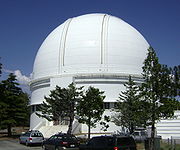 |
120″ 305 cm |
1283 m (4209 ft) |
1959 |
| 3 | Shajn 2.6m (Crimean 102 in.) Crimean Astrophysical Obs. Crimean Astrophysical Observatory The Crimean Astrophysical Observatory is located in Ukraine. CrAO has been publishing the Bulletin of the Crimean Astrophysical Observatory since 1947, in English since 1977. The observatory facilities are located near the settlement of Nauchny since the mid-1950s; before that, they were further... |
102″ 260 cm |
600 m (1969 ft) |
1961 | |
| 4 | Hooker Telescope Mount Wilson Obs. Mount Wilson Observatory The Mount Wilson Observatory is an astronomical observatory in Los Angeles County, California, United States. The MWO is located on Mount Wilson, a 5,715 foot peak in the San Gabriel Mountains near Pasadena, northeast of Los Angeles... |
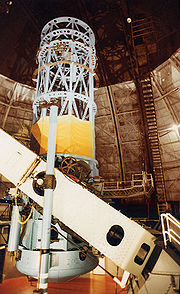 |
100″ 254 cm |
1742 m (5715 ft) |
1917 |
| 5 | Isaac Newton Telescope Royal Greenwich Obs. (1967-1979) |
98″ 249 cm |
|
1965 | |
| 6 | KPNO 2.1 m Telescope Kitt Peak National Obs. Kitt Peak National Observatory The Kitt Peak National Observatory is a United States astronomical observatory located on 2,096 m Kitt Peak of the Quinlan Mountains in the Arizona-Sonoran Desert on the Tohono O'odham Nation, southwest of Tucson... |
83″ 211 cm |
2,070 m 6791 ft |
1964 | |
| 7 | Otto Struve Telescope Otto Struve Telescope The Otto Struve Telescope was the first major telescope to be built at McDonald Observatory. Located in the Davis Mountains in West Texas, the Otto Struve Telescope was designed by Warner & Swasey Company and constructed between 1933 and 1939 by the Paterson-Leitch Company. Its 2.1 meter mirror... McDonald Obs. McDonald Observatory The McDonald Observatory is an astronomical observatory located near the unincorporated community of Fort Davis in Jeff Davis County, Texas, United States. The facility is located on Mount Fowlkes and Mount Locke in the Davis Mountains of West Texas... |
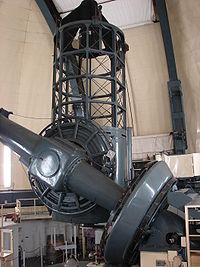 |
82″ 208 cm |
2070 m (6791 ft) |
1939 |
1984
INT began its new life atop a Spanish mountain island in 1984, with a new mirror and dome.Large visible-light optical ground telescopes in 1984:
| Name / Observatory |
Image | Aperture | M1 Area |
Altitude | First Light |
|
|---|---|---|---|---|---|---|
| n Northern Hemisphere The Northern Hemisphere is the half of a planet that is north of its equator—the word hemisphere literally means “half sphere”. It is also that half of the celestial sphere north of the celestial equator... |
BTA-6 BTA-6 The BTA-6 is a 6 m aperture optical telescope at the Special Astrophysical Observatory located in the Zelenchuksky District on the north side of the Caucasus Mountains in southern Russia... Special Astrophysical Obs |
238″ 605 cm |
26 m² | 2070 m (6791 ft) |
1975 | |
| n | Hale Telescope Hale telescope The Hale Telescope is a , 3.3 reflecting telescope at the Palomar Observatory in California, named after astronomer George Ellery Hale. With funding from the Rockefeller Foundation, he orchestrated the planning, design, and construction of the observatory, but did not live to see its commissioning... Palomar Obs. Palomar Observatory Palomar Observatory is a privately owned observatory located in San Diego County, California, southeast of Pasadena's Mount Wilson Observatory, in the Palomar Mountain Range. At approximately elevation, it is owned and operated by the California Institute of Technology... |
 |
200″ 508 cm |
20 m² | 1713 m (5620 ft) |
1949 |
| n | Multiple Mirror Telescope MMT Observatory The MMT Observatory is an astronomical observatory on the site of Fred Lawrence Whipple Observatory . The Whipple observatory complex is located on Mount Hopkins, Arizona, USA in the Santa Rita Mountains... Fred Lawrence Whipple Obs. Fred Lawrence Whipple Observatory The Fred Lawrence Whipple Observatory is an astronomical observatory owned and operated by the Smithsonian Astrophysical Observatory and is their largest field installation outside of their main site in Cambridge, MA... |
1.8 m x 6 6+ or 4.7 m |
m² | 2617 m (8585 ft) |
1979 | |
| n | Mayall Telescope Nicholas U. Mayall Telescope The Nicholas U. Mayall Telescope is a four meter reflector telescope located at the Kitt Peak National Observatory and named after Nicholas U. Mayall. It saw first light on February 27, 1973. Initial observers included: D. Crawford, Nicholas Mayall, and Arthur Hoag. It was dedicated on June 20,... Kitt Peak National Obs. Kitt Peak National Observatory The Kitt Peak National Observatory is a United States astronomical observatory located on 2,096 m Kitt Peak of the Quinlan Mountains in the Arizona-Sonoran Desert on the Tohono O'odham Nation, southwest of Tucson... |
158″ 401 cm |
10 m² | 2120 m (6955 ft) |
1973 | |
| s | CTIO 4m/Blanco Victor M. Blanco Telescope The Víctor M. Blanco Telescope, also known as the Blanco 4m, is a 4m telescope located at the Cerro Tololo Inter-American Observatory, Chile. Commissioned in 1974 and completed in 1976, this telescope is similar to the Mayall 4m telescope located on Kitt Peak. In 1995 it was dedicated and named in... CTIO Obs. Cerro Tololo Inter-American Observatory The Cerro Tololo Inter-American Observatory is a complex of astronomical telescopes and instruments located at 30.169 S, 70.804 W, approximately 80 km to the East of La Serena, Chile at an altitude of 2200 metres. The complex is part of the National Optical Astronomy Observatory along with Kitt... |
158″ 401 cm |
10 m² | 2200 m (7217 ft) |
1976 | |
| s Southern Hemisphere The Southern Hemisphere is the part of Earth that lies south of the equator. The word hemisphere literally means 'half ball' or "half sphere"... |
Anglo-Australian Telescope Anglo-Australian Telescope The Anglo-Australian Telescope is a 3.9 m equatorially mounted telescope operated by the Australian Astronomical Observatory and situated at the Siding Spring Observatory, Australia at an altitude of a little over 1100 m... Siding Spring Obs. Siding Spring Observatory Siding Spring Observatory near Coonabarabran, New South Wales, Australia, part of the Research School of Astronomy & Astrophysics at the Australian National University , incorporates the Anglo-Australian Telescope along with a collection of other telescopes owned by the Australian National... |
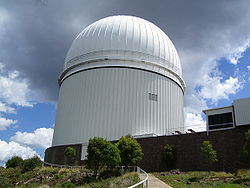 |
153″ 389 cm |
m² | 1742 m (5715 ft) |
1974 |
| n | CFH telescope Canada-France-Hawaii Telescope The Canada–France–Hawaii Telescope is located near the summit of Mauna Kea mountain on Hawaii's Big Island at an altitude of 4,204 meters , and is one of the observatories that comprise the Mauna Kea Observatory... Mauna Kea Obs. |
141″ 358 cm |
m² | 4205 m (13,800ft) |
1979 | |
| s | ESO 3.6 m Telescope ESO European Southern Observatory The European Southern Observatory is an intergovernmental research organisation for astronomy, supported by fifteen countries... La Silla Obs. La Silla Observatory La Silla Observatory is an astronomical observatory in Chile with three telescopes built and operated by the European Southern Observatory organisation, and several others are partly maintained by ESO... |
140″ 357 cm |
8.8 m² | 2400 m (7874 ft) |
1977 | |
| n | MPI-CAHA 3.5m Calar Alto Obs. Calar Alto Observatory The Calar Alto Observatory is an astronomical observatory owned and operated jointly by the Max-Planck-Institut für Astronomie in Heidelberg, Germany, and the Instituto... |
138″ 350 cm |
9 m² |
2168 m (7,113 ft) |
1984 | |
| n | Shane Telescope C. Donald Shane telescope The C. Donald Shane telescope is a reflecting telescope located at the Lick Observatory in California. It was named after astronomer C. Donald Shane in 1978, who led the effort to acquire the necessary funds from the California Legislature, and who then oversaw the telescope's construction... Lick Observatory Lick Observatory The Lick Observatory is an astronomical observatory, owned and operated by the University of California. It is situated on the summit of Mount Hamilton, in the Diablo Range just east of San Jose, California, USA... |
 |
120″ 305 cm |
m² | 1283 m (4209 ft) |
1959 |
| n | Harlan J. Smith Telescope Harlan J. Smith Telescope The Harlan J. Smith Telescope is a 2.7m telescope located at the McDonald Observatory, in Texas, in the United States. This telescope is one of several research telescopes that are part of the University of Texas at Austin observatory perched atop Mount Locke in the Davis Mountains of west Texas... McDonald Observatory McDonald Observatory The McDonald Observatory is an astronomical observatory located near the unincorporated community of Fort Davis in Jeff Davis County, Texas, United States. The facility is located on Mount Fowlkes and Mount Locke in the Davis Mountains of West Texas... |
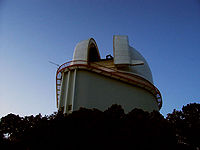 |
107″ 270 cm |
2070 m (6791 ft) |
1968 | |
| n | Shajn 2.6m (Crimean 102 in.) Crimean Astrophysical Obs. Crimean Astrophysical Observatory The Crimean Astrophysical Observatory is located in Ukraine. CrAO has been publishing the Bulletin of the Crimean Astrophysical Observatory since 1947, in English since 1977. The observatory facilities are located near the settlement of Nauchny since the mid-1950s; before that, they were further... |
102″ 260 cm |
600 m (1969 ft) |
1961 | ||
| n | BAO 2.6 telescope Byurakan Astrophysical Obs. |
102″ 260 cm |
1500 m (5000 ft) |
1976 | ||
| n | Isaac Newton Telescope ORM Obs. Roque de los Muchachos Observatory Roque de los Muchachos Observatory is an astronomical observatory located in the municipality of Garafía on the island of La Palma in the Canary Islands... (1980-Present) |
 |
100″ 254 cm |
2396 m (7,860 ft) |
1984 | |
| s | du Pont telescope Las Campanas Obs. Las Campanas Observatory Las Campanas Observatory is an astronomical observatory owned and operated by the Carnegie Institution for Science It was established in 1969 and remains the primary observing site of that institution. The headquarters is located in La Serena, Chile and the observatory is in the southern Atacama... |
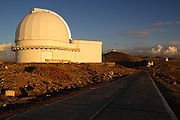 |
100″ 254 cm |
2380 m (7841 ft) |
1976 | |
| n | Hooker Telescope Mount Wilson Obs. Mount Wilson Observatory The Mount Wilson Observatory is an astronomical observatory in Los Angeles County, California, United States. The MWO is located on Mount Wilson, a 5,715 foot peak in the San Gabriel Mountains near Pasadena, northeast of Los Angeles... |
 |
100″ 254 cm |
1742 m (5715 ft) |
1917 |
See also
- Newton's ReflectorNewton's ReflectorThe first reflecting telescope built by Sir Isaac Newton in 1668 is a landmark in the history of telescopes, being the first known successful reflecting telescope. It was the prototype for a design that later came to be called a newtonian telescope....
- International Year of Astronomy commemorative coin

